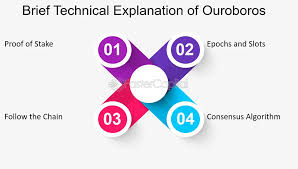How Cardano’s Ouroboros Protocol Secures the Network
Cardano is one of the most respected blockchain platforms in the crypto space, and at the heart of its security lies Ouroboros, its unique proof-of-stake (PoS) consensus protocol. While many blockchains rely on variations of proof-of-work or simplified PoS models, Cardano’s Ouroboros is a peer-reviewed, mathematically proven system that blends energy efficiency with high security. For anyone curious about how the ADA network remains resilient and decentralized, understanding Ouroboros is essential.
Unlike proof-of-work protocols like Bitcoin, where miners solve complex puzzles to validate transactions and earn rewards, Ouroboros selects validators based on the amount of ADA they stake. The more ADA a participant stakes, the higher the chance they have to be selected as a slot leader who proposes the next block. However, Ouroboros is not just about stake size — it’s built on a foundation of cryptographic randomness and epoch-based time structures that make it both secure and fair.
Time on the Cardano network is divided into epochs and slots. Each epoch consists of many slots, which are short periods during which a block can be created. A lottery system determines which stake pool gets to produce a block in a given slot. This lottery is based on verifiable random functions, which ensure that the selection is fair, unpredictable, and immune to manipulation. This design enhances ADA PoS security by preventing attackers from predicting or influencing future block production.
One of the most notable strengths of Ouroboros is its energy efficiency. Since it doesn’t rely on massive computational power to validate blocks, it consumes only a fraction of the electricity used by traditional proof-of-work systems. This makes it environmentally sustainable and scalable, especially as blockchain adoption grows. At the same time, it avoids the centralization issues seen in some PoS systems by encouraging wide delegation through mechanisms like saturation thresholds that prevent any one pool from gaining excessive influence.
Another key aspect of Cardano consensus is its layered approach to security. Ouroboros has gone through several iterations, starting with Ouroboros Classic, then transitioning to Ouroboros Praos, and now preparing for Ouroboros Leios and further enhancements. Each version improves on the last by adding new protections against adversarial behavior, such as network delays, sybil attacks, and dishonest nodes. These upgrades are informed by academic research and rigorously tested before deployment, which is rare in the fast-paced world of blockchain development.
Ouroboros also supports a delegation model, allowing ADA holders to participate in securing the network without running a node themselves. Users can delegate their stake to a pool, which then helps validate transactions on their behalf. Rewards are distributed proportionally based on stake contribution. This not only strengthens decentralization but also aligns incentives across the network. Everyone has a reason to act honestly — pool operators want consistent performance, and delegators want their rewards to grow over time.
Another feature that boosts security is the deterministic finality of the Cardano blockchain. Once a block is added and a sufficient number of blocks follow it, the chances of it being reversed drop significantly. This gives users and developers confidence in the permanence of their transactions. Combined with cryptographic time-stamping and randomized validator selection, Ouroboros creates a robust defense against double-spending and other malicious activities.
As blockchain adoption increases, scalability becomes a concern. Ouroboros addresses this through its modularity. The upcoming Hydra upgrade complements Ouroboros by allowing parallel transaction processing on off-chain mini ledgers. This keeps the main chain secure and efficient while scaling throughput as needed.
In conclusion, Cardano’s Ouroboros protocol offers a sophisticated and secure foundation for the ADA network. It combines the energy efficiency of proof-of-stake with deep academic research and innovative engineering. Through its careful design, Cardano ensures that decentralization, sustainability, and high security go hand in hand — making it one of the most reliable consensus mechanisms in the industry today.







